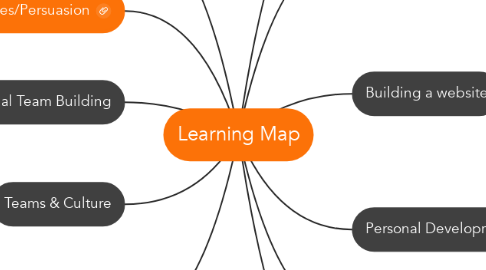
1. Virtual Team Building
1.1. The 'why' and 'how' building virtual teams
1.1.1. Sales, Persuasion and Mission
1.1.2. Networking with a Mission
1.1.3. Incentive Structures
1.2. Organising a Virtual Team
1.2.1. Communication
1.2.2. Storage
1.2.3. Project Management
1.3. Onboarding
1.3.1. Case Study: Kairos Society
1.4. Virtual Team Building Practices
1.4.1. Family Calls
1.4.2. Virtual Work Sessions
2. Teams & Culture
2.1. Founding Teams
2.1.1. Pre-launch
2.1.2. Equity Splits
2.1.3. Size and Composition
2.1.4. Roles and Decision Making
2.1.5. Compensation
2.1.6. Application Task #1
2.2. Team Constellation
2.2.1. Diversity
2.2.2. Background and Composition
2.2.3. Application Task #2
2.3. Managing Teams
2.3.1. Alignment
2.3.2. Leadership
2.3.3. Psychological Safety
2.3.4. Radical Candor
2.3.5. Application Task #3
2.4. Culture
2.4.1. Organisational Knowledge
2.4.2. Organisational Blueprints
3. Networking and Social Capital
3.1. Managing Knowledge
3.1.1. Collective Intelligence
3.1.2. Application Task #4
3.2. Social Capital
3.2.1. Importance of Social Capital for Entrepreneurs
3.2.2. Forms of Social Capital
3.2.3. Dunbar's Number
3.3. Networking Mechanisms
3.3.1. Weak Ties and Strong Ties
3.3.2. Network Oscillation
3.3.3. Structural Holes
3.3.4. Networks and Social Media
4. Productivity Tools
4.1. Introduction
4.1.1. Meaning
4.1.2. Why Productivity Tools?
4.2. Communication Tools
4.2.1. Slack
4.2.2. Krisp
4.2.3. Zoom
4.2.4. Calendly
4.2.5. Doodle
4.2.6. Superhuman
4.3. Project Management Tools
4.3.1. Asana
4.4. CRM tools
4.4.1. Streak
4.4.2. Mailchimp
4.4.3. Notion
4.5. Other Useful Tools
4.5.1. Paste
4.5.2. Pocket
4.5.3. Alfred
4.5.4. Typeform
4.6. Where to start
4.6.1. Less is More
4.6.2. How to be more productive
4.6.3. Productivity Do's and Don'ts
5. Content Marketing
5.1. Getting Your Content Right
5.1.1. Content categories
5.1.2. Content formats
5.1.3. Application Task #2: Generation
5.2. Content Marketing Tools
5.2.1. Designing Content: Leveraging the Content Vortex and MayVary PlugAndPlay
5.2.2. Scheduling and Managing Content
5.2.3. Application Task #3: Activation
5.3. Metrics and Data Analytics
5.3.1. Types of Metrics
5.3.2. Application Task 4: Analysis
5.4. Introduction to Content Marketing
5.4.1. What is Content Marketing?
5.4.2. Why does Content Marketing work so well?
5.4.3. Where to post?
5.4.4. Application Task #1: Research
6. Sales/Persuasion
6.1. Persuasion Principles
6.1.1. Purpose and Importance
6.1.2. Underlying Psychological Principles
6.1.3. Human Decision Making
6.1.4. Persuasion in Action
6.1.5. Persuasion in Daily Life
6.1.6. Reflection Questions
6.2. Sales Principles
6.2.1. Purpose and Importance
6.2.2. Communicating Based on Customer Persona
6.2.3. Sales Conversion Framework
6.2.4. Objection Handling
6.2.5. Long Run Sales Succes Mindframe
6.2.6. Reflection Questions
6.3. Pricing Your Solution
6.3.1. For B2B Solutions
6.3.2. For B2C Solutions
6.3.3. Reflection Questions
7. Building a website
7.1. Introduction to Web Development
7.1.1. Why Web Development?
7.1.2. How Web Development works
7.2. HTML 5
7.2.1. Basic Syntax: Tags and Attributes
7.2.2. Hello World
7.2.3. Tags for the Body
7.2.4. Tags for the Head
7.3. CSS
7.3.1. First CSS Experimentation
7.3.2. CSS Selectors and Conflict Resolution
7.3.3. Positioning
7.3.4. Box Model: Margin,border,padding,content
7.3.5. Media queries & Responsive Design
7.3.6. Flexbox
7.4. Developer Tools
7.5. Bootstrap 4
7.6. Advanced
7.7. Javascript
7.8. Further Resources
8. NoCode Prototyping Tools
8.1. Information Architecture
8.1.1. User Journeys
8.1.2. Features
8.2. Low-Res Prototyping
8.2.1. Paper Prototyping
8.2.2. Google Slides Prototyping
8.3. High-Res Prototyping
8.3.1. Figma
8.3.2. Proto.io
8.3.3. Framer
8.3.4. Facebook Chatbots
8.4. NoCode Products
8.4.1. Glide
8.4.2. Bubble
8.4.3. Mobile Coach
8.4.4. Shopify
9. Personal Development
9.1. Health
9.1.1. Sleep and its importance
9.1.2. How sleep works
9.1.3. Your hormones
9.1.4. Your circadian rhythm
9.1.5. Mindfulness and its importance
9.1.6. Mindfulness in everyday life
9.1.7. Nutrition and its importance
9.2. Energy
9.2.1. Habits
9.2.2. Willpower
9.2.3. Flow
9.3. Time
9.3.1. Efficiency vs. effectiveness
9.3.2. Clock-based vs. event-based timing
9.3.3. Deep work vs. shallow work
9.3.4. Execution vs. reflection
9.3.5. Time Tracking
10. UI/UX
10.1. Introduction
10.1.1. Important Areas within UX Design
10.1.2. UI/UX Design as an applied Topic
10.2. Understanding your User
10.2.1. Product Pitch
10.2.2. UX Persona
10.2.3. User Journey
10.2.4. Application Task #1
10.3. Design your UI
10.3.1. User Flow
10.3.2. Wireframe
10.3.3. Application Task #2
10.3.4. Prototype
10.3.5. Application Task #3
10.4. Behavior Analytics
11. Business Modelling
11.1. Business models and why you need them
11.1.1. Why Business Models Matter
11.1.2. Business Models and Strategy
11.1.3. Strategy for Entrepreneurs
11.1.4. Getting a feeling for business models
11.1.5. Application Task
11.2. Distribution Strategy
11.2.1. Traction Strategy
11.2.2. Direct versus indirect: Pros and Cons
11.2.3. Application Task #2
11.3. Revenue model
11.3.1. Value creation vs value capture
11.3.2. Three Fundamental Pricing Strategies
11.3.3. Bundling vs unbundling
11.3.4. The Significance of Gross Margin
11.3.5. Bringing it all Together: Pricing as Positioning
